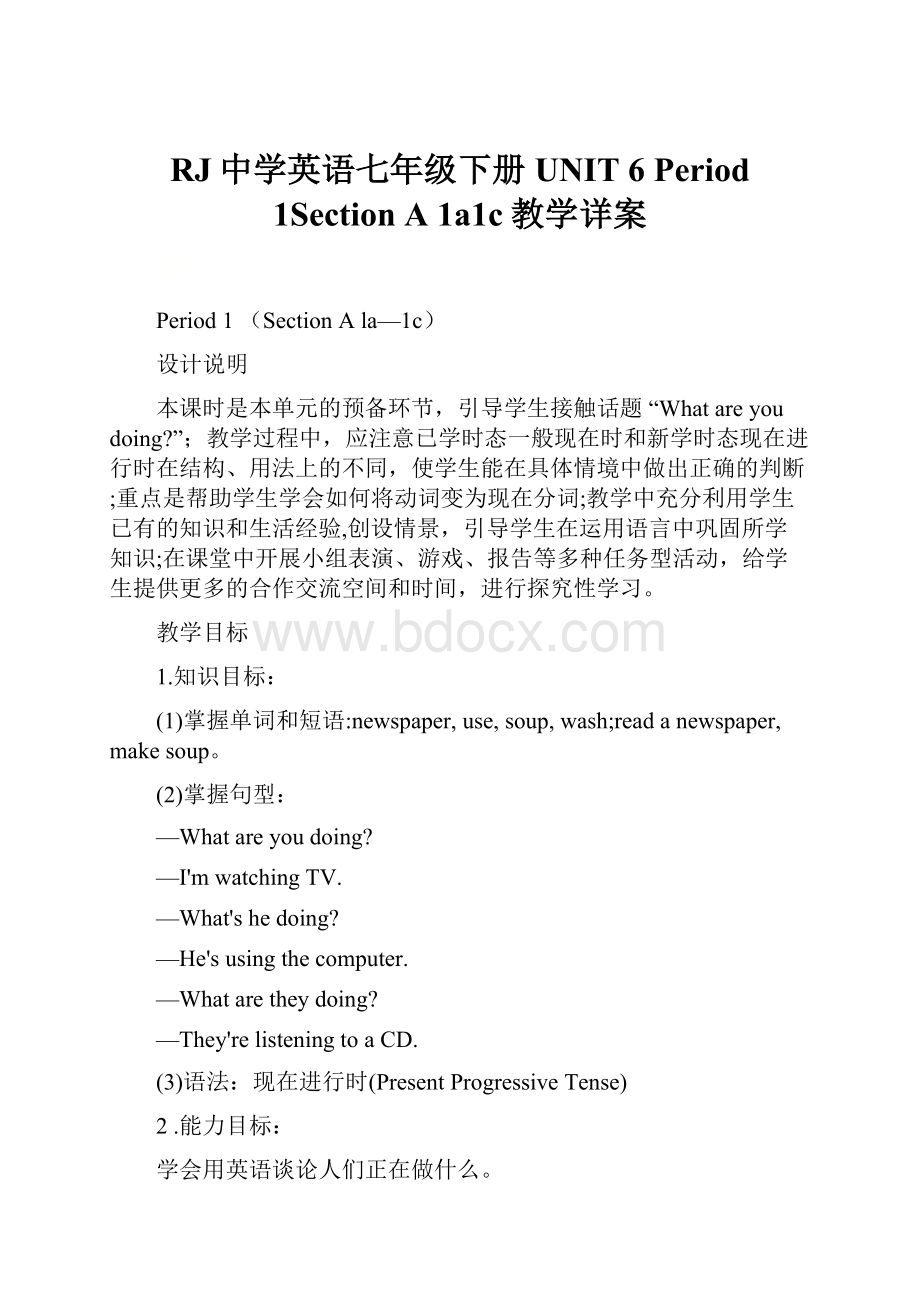RJ中学英语七年级下册UNIT 6 Period 1Section A 1a1c教学详案.docx
《RJ中学英语七年级下册UNIT 6 Period 1Section A 1a1c教学详案.docx》由会员分享,可在线阅读,更多相关《RJ中学英语七年级下册UNIT 6 Period 1Section A 1a1c教学详案.docx(12页珍藏版)》请在冰豆网上搜索。

RJ中学英语七年级下册UNIT6Period1SectionA1a1c教学详案
Period1(SectionAla—1c)
设计说明
本课时是本单元的预备环节,引导学生接触话题“Whatareyoudoing?
”;教学过程中,应注意已学时态一般现在时和新学时态现在进行时在结构、用法上的不同,使学生能在具体情境中做出正确的判断;重点是帮助学生学会如何将动词变为现在分词;教学中充分利用学生已有的知识和生活经验,创设情景,引导学生在运用语言中巩固所学知识;在课堂中开展小组表演、游戏、报告等多种任务型活动,给学生提供更多的合作交流空间和时间,进行探究性学习。
教学目标
1.知识目标:
(1)掌握单词和短语:
newspaper,use,soup,wash;readanewspaper,makesoup。
(2)掌握句型:
—Whatareyoudoing?
—I'mwatchingTV.
—What'shedoing?
—He'susingthecomputer.
—Whataretheydoing?
—They'relisteningtoaCD.
(3)语法:
现在进行时(PresentProgressiveTense)
2.能力目标:
学会用英语谈论人们正在做什么。
3.情感目标:
培养用英语获取信息以及与人合作的能力。
激发学生学习英语的兴趣和热情,使他们在接近生活场景的交际中乐于模仿,敢于开口,积极参与。
重点难点
1.重点:
现在进行时的用法。
2.难点:
(1)现在分词的变化规则。
(2)准确地运用现在进行时来描述和表达正在进行的动作。
教学准备
多媒体课件、录音机、磁带。
教学过程
Step1Leadingin
1.Greetings.
Howareyoutoday?
What'stheweatherliketoday?
2.Singasong.
Walking,walking,walking;
Jumping,Jumping,Jumping;
Running,running,running;
Nowwestop,nowwestop.
Step2Presentation
1.Showsomepicturestopresentthenewexpressions(words,phrasesandthestructureofPresentProgressiveTense“bedoing.
T:
Lookatpicture1.What'sthegirldoing?
Ss:
Sheiscleaning.
T:
Lookatpicture2.What'stheoldmandoing?
Ss:
He’sreadinganewspaper.
(Inthesameway,theteacherteachesotherwordsandphrases:
talkonthephone,listentoaCD,usethecomputer,makesoup,washthedishes,exercise,watchTV.)
2.Usetheactivitiesinthepicturestoanswer:
Whatareyoudoing?
(Helpthestudents)Ss:
I’mcleaning/readinganewspaper...Thenaskthemtopracticeinpairs.
2.Givethestudentssometimeandletthemtrytorememberthenewwordsandphrases.
3.TranslatethefollowingwordsandphrasesintoChinese.
(1)watchTV看电视
(2)clean打扫
(3)readanewspaper看报纸
(4)talkonthephone通过电话交谈
(5)listentoaCD听激光唱片
(6)usethecomputer使用电脑
(7)makesoup做汤
(8)washthedishes洗餐具
(9)exercise锻炼
4.TalkabouttheuseofPresentProgressiveTense.
(1)现在进行时表示且前正在进行的动作,或一段时间内一直发生的动作。
Heiswatching(watch)TVnow.
他现在正在看电视。
Weareworking(work)onafarmthesedays.
这些天我们一直在农场劳动。
(2)现在进行时由“助动词be(am/is/are)+动词-ing形式”构成。
助动词be有(有/没有)人称和数的变化,变化规则与be作连系动词时相同(相同/不相同)。
Iamreading.HeiswatchingTV.Theyareworking.
5.Showthewordsadding“-ing”andaskthestudentstoreadthewordsandthenaskthemtotalkabouttherules.
(1)play→playingdo→doingeat→eatingtalk→talkingwatch→watchingtell→tellingclean→cleaningread→dreading
此类动词-ing形式的变化规则:
直接在词尾加-ing。
(2)take→takinglive→livingwrite→writingmake→makinggive→givingexercise→exercising
此类动词-ing形式的变化规则:
去e再加-ing。
(3)swim→swimmingrun→runningget→gettingstop→stoppingshop→shopping
此类动词-ing形式的变化规则:
双写末尾的辅音字母,再加-ing。
6.Writethefollowingwords'-ingform.
(1)work→working
(2)wait→waiting(3)go→going(4)study→studying(5)have→having
(6)dance→dancing(7)come→coming(8)sit→sitting
Step3Practice
1.Readthelistofwordsandphrasesinlaandaskthestudentstorepeat.
2.Askthestudentstomatchtheactivitieswiththepictures.
Answers:
1.i2.d3.g4.a(i)5.h6.e7.b8.c9.f
3.Describeeachpicturebysaying“He/Sheis...”.
Forexample:
a.Heistalkingonthephone.
b.Sheismakingsoup.
c.Heiswashingthedishes.
d.Heiscleaning.
e.Heisusingthecomputer.
f.Sheisexercising.
g.Heisreidingenewspaper.
h.He/SheislisteningtoaCD.
i.SheiswatchingTV.
4.Pairwork
(1)Askandanswerinpairslikethis:
A:
Whatishedoing?
B:
Heistalkingonthephone.
(2)Imagineyouareoneofthepeopleinthepictures.Practiceinpairslikethis:
A:
Whatareyoudoing?
B:
Iamtalkingonthephone.
Step4Listening
T:
Nowreadthesenamesafterme.
JennyJohnDaveandMary
WhatareJenny,John,DaveandMarydoing?
1.Playtherecordingtwiceforthestudents.
Askthemtolistenandmatchtheactivitieswiththepictures.
2.Checktheanswers.
Answers:
a.1b.8c.5
Step5Pairwork
Askthestudentstoreadtheconversationin1cinpairs.Thenlookatthepicturesinlaandpracticeinpairs.
Model:
T:
What'she/shedoing?
Ss:
He's/She's...
1.Nowworkinpairs.Askandanswerquestionslikethis:
S1:
What'shedoing?
S2:
He's...
2.Asksomestudentstoactitout.
Step6Summary
Inthislesson,wehavelearned:
1.Newwordsandphrases:
newspaper,use,soup,wash;readanewspaper,makesoup
2.Sentencestructures:
—Whatareyoudoing?
—I'mwatchingTV.
—What'shedoing?
—He'susingthecomputer.
—Whataretheydoing?
—They'relisteningtoaCD.
3.Grammar:
PresentProgressiveTense
当堂达标
(一)单项填空
1.—Whatareyoudoing?
—I.
A.eatB.caneatC.eatingD.ameating
2.Ourteacheristhecomputer.
A.useB.usesC.usingD.touse
3.Thatboyisn'ttheteacher.
A.listenB.listensC.listeningD.listeningto
4.Mymotherisacakemybirthday.
A.making;toB.making;for
C.doing;toD.doing;for
5.—youthewindow?
—Yes,Iam.
A.Do;cleanB.Is;cleaningC.Are;cleaningD.Do;cleaning
(二)用所给动词的适当形式填空
1.Look!
Tom(make)soupforus.
2,—Whatareyoudoing?
—I(clean)thehouse.
3.—Whereisyourfather?
—He(wash)hiscarintheyard.
4.Mygrandparentsnewspapers.Theyusuallythematthistime.(read)
5.Manyboysandgirls(run)forexerciseontheplaygroundnow.
(三)句型转换
1.Sheismakingcakes.(就画线部分提问)
isshe?
2.Theyarecleaningtheirclassroom,(改为一般疑问句)
3.AreyoulisteningtoaCD?
(作否定回答)
4.Jimstandsunderthetree.(改用现在进行时表达)
5.Hermotherismakingsoup.(改为否定句)
Hermothersoup.
(四)根据汉语意思完成句子
1.史蒂夫正在通过电话交谈。
Steve.
2.咱们出去吃饭吧!
Let!
3.我妈妈正在做汤。
Mymother.
4.李雷正在使用电脑吗?
IsLiLeia?
5.汤姆晚饭后经常洗餐具。
Tomoftenafterdinner.
(五)补全对话
A:
IsthatLucy?
ThisisKatespeaking.
B:
Hello,Kate!
Whatareyou1.?
A:
I'm2.abook.It'sboring.
B:
Doyouwanttogotothe3.thisafternoon?
Thereisanewmovieonshow.
A:
Thatsoundsgreat.CanIaskmysistertogowithus?
B:
4..Whereisyoursister?
A:
She's5.theguitarinherroom.Whendoyouwanttogo?
B:
Let'sgoattwooJclock.
(六)完形填空
Miyoko1.fromJapan.Shelostherparentsin2011.Nowsheis2.inQingdao.Sheis3.atNo.2HighSchool.
Shegetsup4.sixeverymorning.Afterthat,she5.Chinese.She
6.breakfastatseveno’clock.
Nowitisseveno’clockinthemorning.Miyoko7.breakfast8.herChineseparents.
“Haveanotheregg,Miyoko.It'sjust7:
15,”hermothersays.9.,thankyou,Mom.Imustgonow.
WangLiliiswaitingfor(等待)me10.thebusstop.Today,wearehavingaChinesecontest.Bye-bye,Mom.
1.A.amB.isC.beD.are
2.A.belivingB.liveC.livingD.lives
3.A.studiesB.tostudyC.studyingD.study
4.A.forB.onC.inD.at
5.A.readsB.readC.isreadingD.reading
6.A.hasB.ishavingC.tohaveD.having
7.A.hasB.ishavingC.tohaveD.having
8.A.withB.andC.toD.for
9.A.YesB.NotC.NoD.Oh
10.A.forB.atC.onD.in
答案及解析:
(一)1.D根据问句可判断时态是现在进行时,回答也应用现在进行时,其结构为“be(am/is/are)+动词-ing形式,故选D。
2.C由空格前的be动词is可知,句子应用现在进行时,use的现在分词为using,故选C。
3.D“听某人讲话"用listentosb.表示。
4.B“做蛋糕”用makeacake表示;“为我的生日”用介词for。
5.C根据选项可知问句为“你正在擦窗户吗?
”。
表示“正在做某事”用现在进行时,其结构为“be(am/is/are)+动词-ing形式”。
排除A、D两项;问句主语为you,be动词用are,故选C。
(二)1.ismaking2.amcleaning3.iswashing4.arereading;read5.arerunning
(三)1.What,doing该句是现在进行时,对做某事进行提问用what,句子时态不变。
2.Aretheycleaningtheirclassroom?
现在进行时的肯定句变一般疑问句把be动词放在句首。
3.No,I'mnot.以“Areyou...?
"开头的一般疑问句,肯定回答用Yes,Iam/weare.否定回答用No,I'mnot/wearen't.
4.Jimisstandingunderthetree.现在进行时的结构为“be(am/is/are)+动词-ing形式”,故用isstanding代替stands。
5.isn'tmaking含有be动词的句子,变为否定句时应在be后加not,isnot可缩写为isn’t,故答案为isn'tmaking。
(四)1.istalkingonthephonetalkonthephone意为“通过电话交谈”。
由汉语意思可知需用现在进行时,其结构为“be(am/is/are)+v.-ing”,主语为Steve,be动词应用is。
2.eatouteatout意为“出去吃饭”。
Let's后接动词原形。
3.ismakingsoupmakesoup意为“做汤”;由汉语意思可知本句用现在进行时;make的现在分词需去e,再加-ing;主语为mymother,be动词用is。
4.using,computeruseacomputer意为“使用电脑",因题中有is,动词应用-ing形式,use的现在分词需去e,再加-ing。
5.washesthedisheswashthedishes意为“洗餐具";由句中often和主语Tom可知谓语动词wash需用第三人称单数形式washes。
(五)1.doing2.reading3.movies4.Yes/OK/Sure5.playing
(六)l.Bbefrom意为“来自”,主语是第三人称单数,谓语动词也要用单数形式,故选B。
2.C由句中now可知该句为现在进行时,其结构为“is/am/are+n.-ing”,句中已有be动词is,故选C。
3.C由前面的is可知此处用studying构成现在进行时结构。
4.D在时间点前用介词at。
5.A由前一句可知此句用一般现在时。
主语是she,谓语动词应用第三人称单数形式,故选A。
6.A由句意“她7点钟吃早饭”可知本句用一般现在时;主语是she,故谓语动词用第三人称单数形式,应选A。
7.B由上一句中的now可知Miyoko正在吃早饭,应用现在进行时,故选B。
8.Awith和……起。
9.C由后面的“Imustgonow.”可知,Miyoko不吃鸡蛋了,故用No。
10.Batthebusstop“在公共汽车站"。
Step7Homework
1.Copyandrememberthewordsandphrasesinthislesson.
2.Practice1c.
板书设计
UNIT6I'mwatchingTV.
Period1(SectionAla—1c)
watchTVcleanreadanewspaper
talkonthephonelistentoaCD
usethecomputermakesoup
washthedishes
exercise
—Whatareyoudoing?
—I'm...
—What'she/shedoing?
—He's/She's...
—Whataretheydoing?
—They're...
教学反思